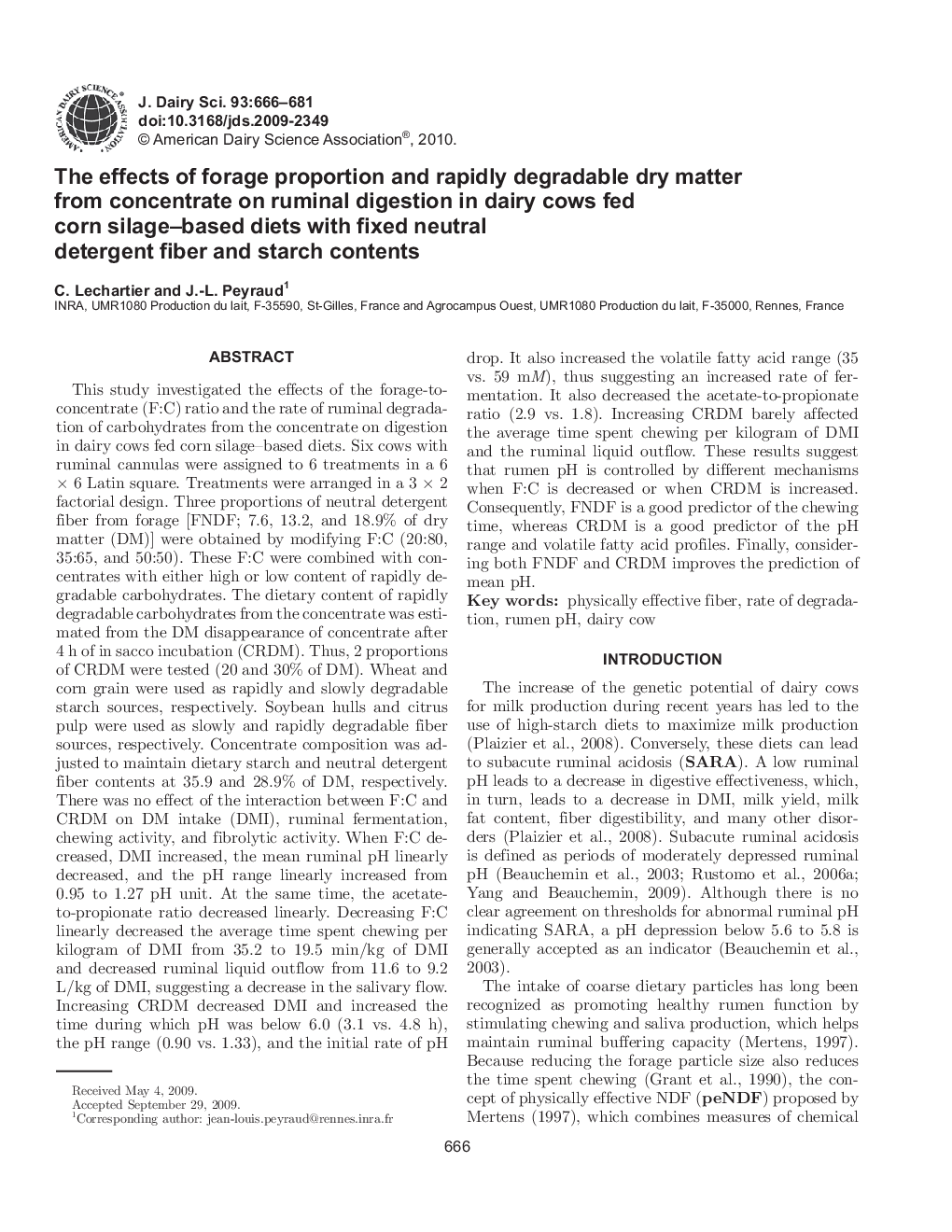| کد مقاله | کد نشریه | سال انتشار | مقاله انگلیسی | نسخه تمام متن |
|---|---|---|---|---|
| 5789782 | 1108084 | 2010 | 16 صفحه PDF | دانلود رایگان |

This study investigated the effects of the forage-to-concentrate (F:C) ratio and the rate of ruminal degradation of carbohydrates from the concentrate on digestion in dairy cows fed corn silage-based diets. Six cows with ruminal cannulas were assigned to 6 treatments in a 6Â ÃÂ 6 Latin square. Treatments were arranged in a 3Â ÃÂ 2 factorial design. Three proportions of neutral detergent fiber from forage [FNDF; 7.6, 13.2, and 18.9% of dry matter (DM)] were obtained by modifying F:C (20:80, 35:65, and 50:50). These F:C were combined with concentrates with either high or low content of rapidly degradable carbohydrates. The dietary content of rapidly degradable carbohydrates from the concentrate was estimated from the DM disappearance of concentrate after 4Â h of in sacco incubation (CRDM). Thus, 2 proportions of CRDM were tested (20 and 30% of DM). Wheat and corn grain were used as rapidly and slowly degradable starch sources, respectively. Soybean hulls and citrus pulp were used as slowly and rapidly degradable fiber sources, respectively. Concentrate composition was adjusted to maintain dietary starch and neutral detergent fiber contents at 35.9 and 28.9% of DM, respectively. There was no effect of the interaction between F:C and CRDM on DM intake (DMI), ruminal fermentation, chewing activity, and fibrolytic activity. When F:C decreased, DMI increased, the mean ruminal pH linearly decreased, and the pH range linearly increased from 0.95 to 1.27 pH unit. At the same time, the acetate-to-propionate ratio decreased linearly. Decreasing F:C linearly decreased the average time spent chewing per kilogram of DMI from 35.2 to 19.5Â min/kg of DMI and decreased ruminal liquid outflow from 11.6 to 9.2Â L/kg of DMI, suggesting a decrease in the salivary flow. Increasing CRDM decreased DMI and increased the time during which pH was below 6.0 (3.1 vs. 4.8Â h), the pH range (0.90 vs. 1.33), and the initial rate of pH drop. It also increased the volatile fatty acid range (35 vs. 59Â mM), thus suggesting an increased rate of fermentation. It also decreased the acetate-to-propionate ratio (2.9 vs. 1.8). Increasing CRDM barely affected the average time spent chewing per kilogram of DMI and the ruminal liquid outflow. These results suggest that rumen pH is controlled by different mechanisms when F:C is decreased or when CRDM is increased. Consequently, FNDF is a good predictor of the chewing time, whereas CRDM is a good predictor of the pH range and volatile fatty acid profiles. Finally, considering both FNDF and CRDM improves the prediction of mean pH.
Journal: Journal of Dairy Science - Volume 93, Issue 2, February 2010, Pages 666-681